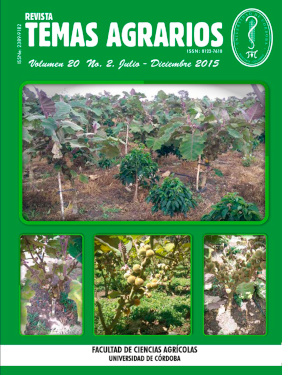Implementation of the methodology QuEChERS in the residual pesticide analysis in white corn (Zea mays)
Implementación de la metodología QuEChERS en el análisis de residuos de plaguicidas en maíz blanco (Zea mays)
How to Cite
Páez, M., & Martínez, J. (2015). Implementation of the methodology QuEChERS in the residual pesticide analysis in white corn (Zea mays). Sour Topics, 20(2), 30-42. https://doi.org/10.21897/rta.v20i2.756
Dimensions
license

This work is licensed under a Creative Commons Attribution-NonCommercial 4.0 International License.
Show authors biography
Article visits 1662 | PDF visits
Downloads
Download data is not yet available.
- Ahumada, D. y Guerrero, J. 2010. Estudio del efecto matriz en el análisis de plaguicidas por cromatografía de gases.Vitae 17(1): 51-58.
- Anastassiades, M., Lehotay, S., Stajnbaher, D. y Schenck, F. 2003. Fast and easy multiresidue method employing acetonitrile extraction/partitioning and dispersive solid-phase extraction for the determination of pesticide residues in produce. Journal of AOAC International 86(2): 412-431.
- AOAC 2007. AOAC Offiial Method 2007.01. Pesticide Residues in Foods by Acetonitrile Extraction and Partitioning with Magnesium Sulfate. http://www.weber.hu/PDFs/QuEChERS/AOAC_2007_01.pdf [5 Mayo 2015].
- BS EN 15662:2008 2008. Foods of plant origin-determination of pesticide residues using GC-MS and / or LC-MS / MS following acetonitrile extraction / partitioning and clean- up by dispersive SPE-QuEChERS method. http://www. chromnet.net/Taiwan /QuEChERS_Dispersive_SPE/QuEChERS_%E6%A D % 9 0 % E 7 % 9 B % 9 F %E 6 % 9 6 % B 9 % E 6 % B 3 % 9 5 _EN156622008_E.pdf [5 Mayo 2015].
- Chen, G., Pengying, C. y Renjiang, L. 2011. A multi-residue method for fast determination of pesticides in tea by ultra performance liquid chromatography– electrospray tandem mass spectrometry combined with modifid QuEChERS sample preparation procedure. Food Chemistry 125(4):1406-1411.
- Cieślik, E., Sandowska-Rociek, A., Molina, J. y Surma-Zadora, M. 2011. Evaluation of QuEChERS Method for the Determination of Organochlorine Pesticide Residues in Selected Groups of Fruits. Food Chemistry 125(2):773-778.
- Erney, D., Gillespie, A., Gilvydis, D. y Poole, C. 1993. Explanation of the MatrixInduced Chromatographic Response Enhancement of Organophosphorus Pesticides during Open Tubular Column Gas Chromatography with Splitless or Hot on-Column Injection and Flame Photometric Detection. Journal of Chromatography A 638 (1):57-63.
- European Commission 2015. EU-Pesticides Database-Pesticides EU-MRLs Regulation (EC) No 396/2005. http://ec.europa.eu/ Páez et al. - Residuos de plaguicidas en maíz blanco 42dgs/health_food safety/index_en.htm [18 Octubre 2015].
- FAO 2001. Depósito de documentos. El Maíz En Los Trópicos: Mejoramiento y Producción. http://www.fao.org/
- docrep/003/x7650s/x7650s00.htm#toc [1 Octubre 2015].
- ICONTEC 2003. Norma técnica colombiana NTC 2227: granos y cereales, maíz, determinación del contenido de humedad (en granos enteros y en granos molidos). http://icontec.org/index.php/es/e-normas [9 Octubre 2015].
- Koesukwiwat, U., Lehotay, S., Miao, S., y Leepipatpiboon, N. 2010. High Throughput analysis of 150 pesticides in fruits and vegetables using QuEChERS and low-pressure gas chromatography– time-of-flght mass spectrometry. Journal of Chromatography A 1217(43):6692- 6703.
- Lehotay, S. y Anastassiades, M. 2005. Combination of Analyte Protectants To Overcome Matrix Effects in Routine GC Analysis of Pesticide. Analytical Chemistry 77 (24): 8129–8137.
- Lehotay, S., Maštovská, K. y Yun, S. 2005. Evaluation of Two Fast and Easy Methods for Pesticide Residue Analysis in Fatty Food Matrixes. Journal of AOAC International 88(2): 630-638.
- Lehotay, S., Son, K., Kwon, H., Koesukwiwat, U., Fu, W., Mastovska, K., Hoh, E. y Leepipatpiboon, N. 2010. Comparison of QuEChERS sample preparation methods for the analysis of pesticide residues in fruits and vegetables. Journal of Chromatography A 1217(16): 2548-2560.
- Mastovska, K., Dorweiler, K., Lehotay, S., Wegscheid, J y Szpylka, K. 2010. Pesticide multiresidue analysis in cereal grains using modifid QuEChERS method combined with automated direct sample introduction GC-TOFMS and UPLC-MS/MS techniques. Journal of Agricultural and Food Chemistry 58(10): 5959-5972.
- Nuss, E. y Tanumihardjo, S. 2010. Maize: A Paramount Staple Crop in the Context of Global Nutrition. Comprehensive Reviews in Food Science and Food Safety 9(4): 417-436.
- Poole, C. 2007. Matrix-Induced Response Enhancement in Pesticide Residue Analysis by Gas Chromatography. Journal of Chromatography. A 1158(1-2): 241- 250.
- SANCO 2013. SANCO/12571/2013-Guidance Document on Analytical Quality Control and Validation Procedures for Pesticide Residues Analysis in Food and Feed. http://www.eurl-pesticides.eu/docs/ublic/tmplt_article.asp?CntID=727 [8 Octubre 2015].
- Schenck, F. y Lehotay, S. 2000. Does Further Clean-up Reduce the Matrix Enhancement Effect in Gas Chromatographic Analysis of Pesticide Residues in Food?.Journal of Chromatography A 868(1): 51-61.
- Turiel, E. y Martín-Esteban, A. 2008. Sample handling of pesticides in food and environmental samples. En: Tadeo, J. (Ed). Analysis of pesticides in food and Environmental samples. CRC Press, New York, p35-56.
- USDA/FAS 2014. United states department of agriculture and foreign agricultural service. corn 2014: production, supply, demand database. http://www.pecad.fas.usda.gov/cropexplorer [5 Octubre 2015].
- Zrostlıkova, J. y Hajslova, J. 2003. Matrix Effects in ( Ultra ) Trace Analysis of Pesticide Residues in Food and Biotic Matrices. Journal of Chromatography 1000(1-2):181-197.




















